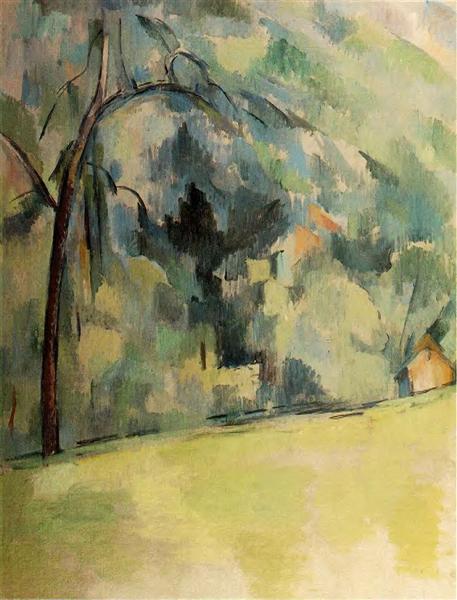Beschrijving
Paul Cézanne's Morning in Provence (1906) is a fascinating example of the transition between Impressionism and Post-Impressionism, characteristics that define the artist and position him as one of the most influential figures in the history of Western art. Originally from Aix-en-Provence, Cézanne never failed to find inspiration in the landscape of his native region, and this piece reflects his deep sense of connection with the natural environment that surrounded him.
In "Morning in Provence," the composition is remarkably balanced, organized in an almost topographical order that appears simultaneously rigid and fluid. The work features a series of natural elements that capture the typical light and atmosphere of a morning in the south of France. The robust trees that frame the scene are treated with an almost sculptural characterization, their forms rendered with firm brushstrokes that suggest volume and solidity, a technique that Cézanne frequently used to investigate the relationship between objects and their two-dimensional representation.
The use of color is particularly significant in this painting. Cézanne employs a palette of soft, earthy tones, evoking both the abundance of vegetation and the morning light that bathes the landscape. The warm temperatures of the yellows and oranges contrast with the blues and greens, creating a visual harmony that invites the viewer to experience the warmth of the dawning day. This contrast in coloration, along with the application of short, decisive brushstrokes, reflects a concern with visual perception and the subjective experience of color, which are recurring themes in Cézanne's work.
Although Morning in Provence does not prominently feature human figures, the relationship between humanity and the natural environment is an important subtextual element throughout Cézanne's work. The absence of figures can be interpreted as a call to introspection, an invitation to viewers to contemplate the beauty and serenity of the landscape for themselves, independent of human presence. This reinforces the idea that the natural environment has its own life and story to tell, even in the silence of pictorial representation.
When looking at the work, it is also interesting to note how Cézanne uses the structure of the composition to direct the eye. Paths and lines formed by the vegetation guide the viewer through the landscape, creating a sense of depth and perspective reminiscent of the approaches of the Renaissance masters, albeit reinterpreted through a modern lens. Cézanne moves away from exact representation and into the exploration of form and structure, resulting in a work of art that fundamentally challenges traditional notions of landscape.
The significance of Morning in Provence goes beyond its own aesthetic; it is often seen as a step towards the abstraction that would later be explored by artists in the 20th century. Its analytical approach to light and form is evident in the work of many of the artists who followed him, who saw in Cézanne a master who had managed to overcome the limitations of impressionist technique, thus laying the groundwork for modern art movements.
In this sense, "Morning in Provence" not only reflects the beauty of the Provencal landscape, but also captures the essence of Cézanne's artistic quest: a search for truth in form and color. As a temporal bridge between the past and the future of art, this work invites a deep reflection on the human-nature relationship and on the visual language that art can offer to interpret them. In short, we can observe that the simplicity of the subject contrasts with the complexity of its execution, a distinctive feature of Cézanne's genius.
KUADROS ©, a famous painting on your wall.
Hand-made oil painting reproductions, with the quality of professional artists and the distinctive seal of KUADROS ©.
Painting reproduction service with satisfaction guarantee. If you are not completely satisfied with the replica of your painting, we will refund 100% of your money.

